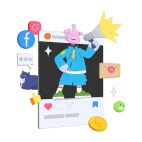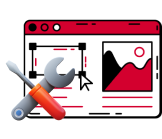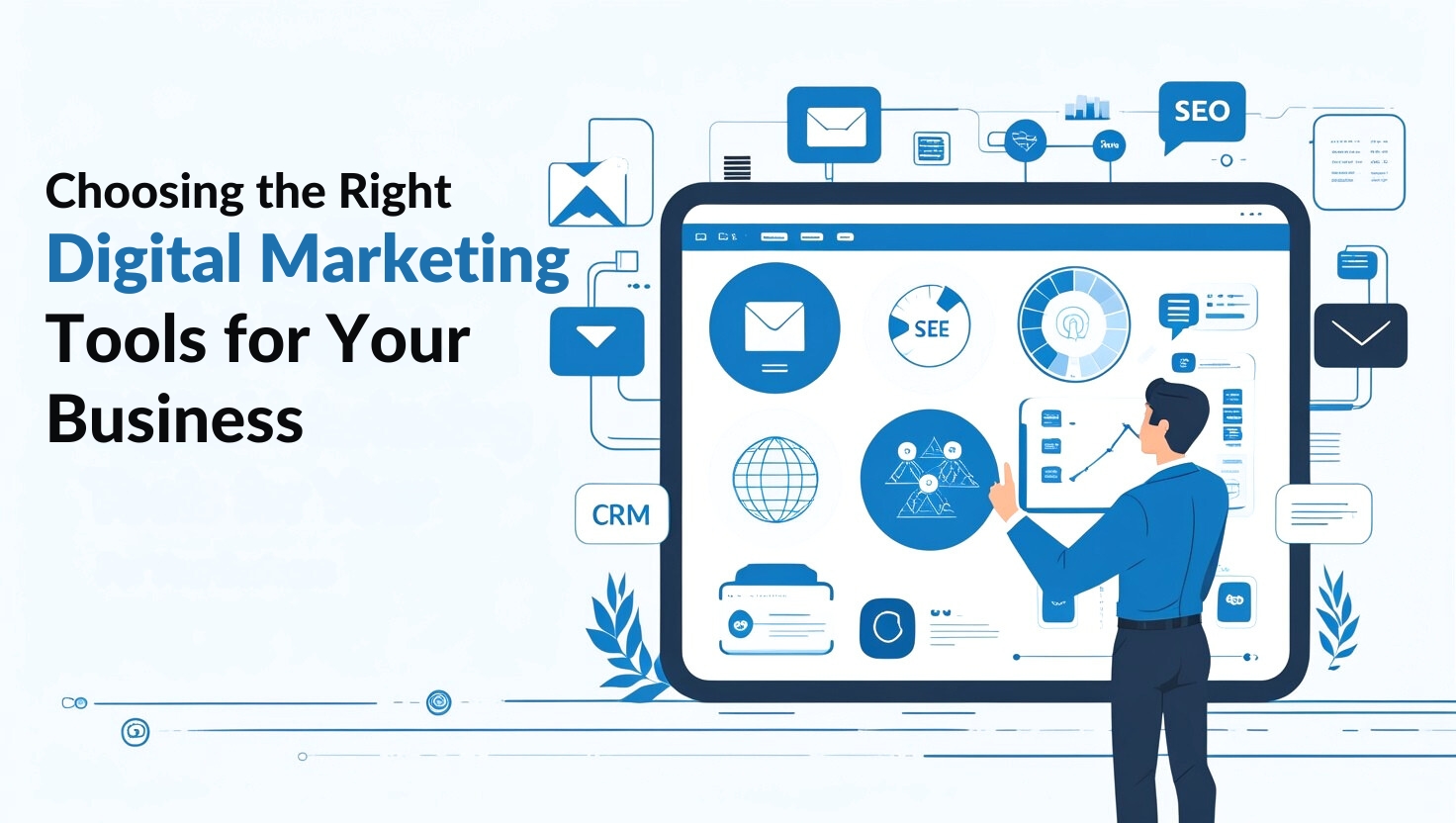Marketing Performance in 2025 Begins With the Right Tools
Marketing in 2025 demands more than creativity, it requires precision, speed, and intelligent execution. The tools powering your campaigns directly influence how efficiently your brand reaches audiences, converts attention into action, and scales with confidence.
Tools as Growth Infrastructure
Today’s marketing platforms serve as operational hubs, enabling teams to launch integrated campaigns, track performance, and adjust strategies in real-time. AI, machine learning, and automation are now built into the most effective tools, transforming how work gets done and how results are measured.
Example: Jasper AI and Surfer SEO combine real-time SERP analysis and natural language processing to help marketers craft content that ranks, engages, and converts faster than ever before.
Budget Efficiency with High Impact
Tool selection now plays a critical role in financial performance. Marketers are consolidating platforms, focusing on functionality that supports multiple objectives while reducing costs. Every tool in the stack must justify its place by contributing directly to pipeline growth or productivity.
Platforms like HubSpot, Metricool, and ClickUp help teams align across content, automation, and reporting, reducing tool overload and improving visibility across campaigns.
First-Party Data as a Strategic Asset
With the decline of third-party cookies, control over owned data has become a competitive advantage. Tools that centralize behavior tracking, user journeys, and real-time analytics empower brands to personalize engagement and make faster decisions.
CRMs, analytics dashboards, and platforms like Google Analytics 4 or ConvertKit provide deeper insight into customer behavior, allowing for sharper targeting and improved lifetime value.
Operational Speed Through Automation
Efficiency now defines success in modern marketing. Manual workflows are being phased out in favor of smart automations that free teams to focus on creative and strategic execution. Tools that automate repetitive tasks, coordinate teams, and accelerate delivery timelines are driving real competitive gains.
Solutions like Zapier, Trello, and ClickUp remove friction from daily operations, allowing marketers to scale without scaling headcount.
Tool Selection Shapes the Customer Journey
Tool selection in 2025 isn't just a tech decision, it's a growth strategy. Marketers equipped with scalable, AI-enhanced, and data-driven tools are outperforming slower, fragmented competitors. The right stack powers speed, precision, and performance across every channel.
Digital marketing is all about crafting seamless, personalized experiences across channels. The tools you use are not just operational aids, they orchestrate how your customers interact with your brand from awareness to advocacy.
Personalization at Scale
Marketing platforms now offer advanced segmentation, behavioral tracking, and predictive algorithms. These features allow you to speak directly to each customer’s needs, at scale. Instead of guessing, marketers now build smart campaigns that adapt in real-time to user behavior.
Tools like ConvertKit and Mailchimp deliver dynamic email content based on clicks, opens, and even browsing history, transforming static newsletters into intelligent conversion engines.
Consistency Across Channels
Customers expect a unified brand experience across touchpoints, social, web, email, mobile, and more. The right tools sync campaigns across platforms, ensuring your message stays consistent while adapting format and tone for each medium.
Buffer, Hootsuite, and Meta Business Suite help you schedule, monitor, and optimize content across social platforms, all from a single dashboard. This coordination reduces content gaps and messaging errors, even for lean teams.
Real-Time Feedback Loops
Today’s marketing doesn’t wait weeks for insights. Analytics tools provide real-time dashboards that measure performance as it happens, enabling faster pivots, smarter optimization, and better outcomes.
Google Analytics 4, Metricool, and Hotjar offer a clear view of what users do, where they drop off, and which content drives engagement. This intelligence lets marketers fix weak points quickly and double down on what’s working.
Tools Elevate Productivity, Creativity, and ROI
In fast-paced digital environments, teams need to move faster without burning out. The right marketing tools don’t just improve campaign output, they enhance collaboration, spark creativity, and deliver measurable returns on effort and investment.
Doing More With Less
AI-powered platforms help lean teams produce enterprise-level content, automate manual tasks, and manage multiple channels without adding headcount. This scalability ensures marketing keeps pace with business growth.
Jasper AI, Grammarly, and ChatGPT support content creation across blogs, ads, and emails, reducing the hours spent writing while improving quality and consistency.
Clarity Across Teams
Disorganized workflows create bottlenecks and burnout. Tools like Trello, Notion, and ClickUp bring clarity by aligning goals, deadlines, and responsibilities. These platforms act as central hubs for marketing operations, keeping everyone on the same page.
With ClickUp’s dashboards or Trello’s editorial calendars, you can plan campaigns, monitor assets, and track team progress in real time, improving accountability and reducing wasted time.
ROI-Driven Decisions
Marketers today are expected to prove impact. Analytics platforms combined with automation tools allow for data-informed decisions that directly tie effort to revenue. Teams that know what’s working spend smarter and scale faster.
Tools like Semrush, Ubersuggest, and Google Looker Studio help track traffic, leads, rankings, and conversions, giving decision-makers the insight needed to drive sustainable growth.
Strategic Marketing Now Starts with the Right Stack
In 2025, growth isn’t powered by guesswork, it’s driven by data, automation, and smart execution. That starts with a carefully curated digital marketing stack. Businesses that rely on disconnected tools or outdated platforms often face more friction than forward motion. On the other hand, brands using a modern, integrated set of marketing tools experience smoother workflows, faster scaling, and more predictable revenue outcomes.
Think of your tool stack as your digital backbone. It determines how efficiently you collect data, how clearly you understand your customers, and how fast you can act on opportunities. A solid stack should eliminate repetitive work, simplify campaign planning, and provide insights you can trust. In 2025, marketers are no longer asking how to do more, they’re asking how to do better, faster, and smarter. That’s only possible with tools designed to complement one another and build momentum across the entire marketing funnel.
Let’s take an example: imagine a business that combines Google Analytics 4 for real-time data, Semrush for keyword and competitor research, Jasper AI for content generation, HubSpot for lead nurturing, and ClickUp for campaign project management. This stack forms a closed loop: insights inform strategy, strategy powers content, content drives leads, leads are nurtured automatically, and performance is continuously optimized. Every tool serves a clear purpose, and every campaign gets stronger over time.
From Chaos to Clarity: Building a System That Scales
One of the biggest shifts happening in digital marketing right now is the transition from chaotic, campaign-based thinking to system-driven marketing operations. The marketers winning in 2025 aren’t just creative, they’re operationally excellent. They’ve stopped scrambling for last-minute content ideas or manually tracking campaign ROI. Instead, they’ve built systems supported by smart tools that help them plan strategically, launch consistently, and scale confidently.
With tools like Trello, Notion, and ClickUp, marketers now run their departments like high-performing product teams, with clear timelines, defined workflows, and data-backed retrospectives. This shift helps businesses move away from reactive marketing to proactive planning. Campaigns get launched on time. Messages stay on-brand. Results improve because the process behind them is strong.
But systems go beyond planning. Automation tools like Zapier or ConvertKit eliminate repetitive tasks, from syncing new leads into your CRM to sending targeted follow-ups automatically. Meanwhile, platforms like ChatGPT and Grammarly reduce creative burnout by assisting with drafts, edits, and ideas, allowing marketers to focus on strategy and innovation. And with Looker Studio, teams can centralize their performance data across channels, giving every stakeholder the visibility they need to stay aligned.
Ultimately, what separates thriving marketers from struggling ones in 2025 is not just talent or budget, it’s how well their tools work together to support a clear, repeatable growth system. Building that system isn’t optional anymore. It’s the competitive advantage of modern marketing.
Data-Led Marketing Is No Longer a Luxury, It's the New Standard
In 2025, data isn’t just part of the process, it is the process. Top-performing marketing teams are no longer making decisions based on assumptions or scattered insights. They’re building their campaigns, content, and strategies around hard numbers that reflect user behavior, conversion trends, and channel performance in real time. And the tools they choose determine the accuracy, accessibility, and speed of that data.
Platforms like Google Analytics 4, Looker Studio, and Google Search Console have evolved into more than just analytics dashboards. When configured properly, they become live control rooms where marketers can monitor user journeys, evaluate campaign ROI, and optimize every touchpoint with clarity. For instance, GA4’s predictive audiences and event-based data model allow brands to build micro-segmented retargeting lists based on actual engagement patterns, not broad demographics.
According to a 2025 report from Statista, companies that integrated real-time analytics tools into their marketing workflows saw a 27% increase in lead quality and a 33% improvement in conversion rates compared to those that relied solely on quarterly reports or spreadsheet-based tracking. This isn't surprising. When you know exactly which traffic source drives the highest LTV, or which landing page loses users at step three, you can take targeted action immediately, not weeks later.
Take e-commerce as an example: brands that use Ubersuggest and Ahrefs together for SEO insights are seeing major wins in organic traffic. These tools don’t just suggest keywords, they help marketers understand how competitors are driving growth, which keywords convert best, and how backlink profiles influence rankings. Meanwhile, Surfer SEO and Jasper AI accelerate content production by turning those insights into fully optimized, AI-assisted blog posts, landing pages, and even product descriptions, all tailored to match current ranking signals.
But data is more than numbers, it’s also about narratives. Tools like Hotjar and Loom give marketers a qualitative lens into their customer experiences. With session recordings and heatmaps, marketers can spot friction points on landing pages, while short personalized Loom videos can help sales teams close the loop with leads in a more human and authentic way. Together, these insights form a full-circle understanding of both quantitative performance and qualitative feedback.
The bottom line: if your tools don’t feed you actionable, real-time insights in 2025, they’re costing you more than time; they’re costing you growth. Smart marketers don’t just gather data. They operationalize it. They build dashboards, link analytics to their ad platforms, and continuously test based on what the numbers reveal. That’s how winning campaigns get built, not once, but at scale.
AI and Automation Are Powering the Next Marketing Evolution
In 2025, artificial intelligence is no longer a buzzword or emerging trend; it’s the silent force driving faster content creation, smarter decision-making, and more efficient workflows across every touchpoint in digital marketing. Today’s leading marketers aren’t just experimenting with AI; they’re integrating it into the foundation of their marketing systems to gain speed, consistency, and scale.
Tools like Jasper AI, ChatGPT, and Writesonic are now essential in the modern content stack. They assist in everything from ideation and keyword targeting to full-scale copywriting. But beyond writing blog posts or ad headlines, AI is now being used to draft sales emails, generate customer support scripts, and even test variations of product messaging, all in minutes, not days.
What sets successful marketers apart in 2025 is how they combine these tools with real-time intent data. For example, a marketer might analyze performance insights in GA4, feed high-intent topics into Surfer SEO or Ubersuggest, generate content briefs with Jasper AI, and publish directly through a CMS connected to ClickUp or Notion. This entire cycle, which once took weeks of collaboration, can now happen in under 48 hours, with AI doing the heavy lifting and humans focused on strategy and refinement.
Automation tools like Zapier are also playing a pivotal role in reducing manual workloads. Marketing teams are setting up zaps that trigger lead nurturing sequences, push Slack notifications when high-value prospects engage, or update CRM fields automatically based on user actions. This kind of seamless automation allows small teams to execute like large ones, without losing the personal touch.
The power of AI is also redefining personalization. In 2025, dynamic email content, predictive product recommendations, and AI-generated video messages are not only possible, they’re expected. Platforms like Mailchimp, ConvertKit, and HubSpot have embraced this shift by integrating machine learning into their segmentation, scoring, and email optimization features. That means your marketing can be uniquely tailored to each individual’s behavior, preferences, and stage in the buyer’s journey, without writing hundreds of variations manually.
But this evolution isn’t just about speed or automation. It’s about freeing marketers from the tactical grind and giving them the bandwidth to focus on strategy, storytelling, and customer empathy. AI is not replacing marketers, it's making them sharper, faster, and more creative. When used wisely, it turns a scattered marketing department into a performance machine.
As we move deeper into 2025, marketing without AI will feel like driving with a blindfold. The tools are ready. The results are proven. And the marketers who embrace this shift are already seeing exponential growth.
Real-World Use Cases: How Digital Marketers Scale with Smart Tools in 2025
Understanding a tool's features is just the starting point. What separates high-performing marketers in 2025 is how they strategically connect these tools to solve real business problems. Let’s dive into powerful, real-world examples of how smart marketers use digital tools to drive performance, save time, and grow their businesses.
Case Study 1: Boosting Organic Traffic with Semrush + Surfer SEO
A growing SaaS startup faced a plateau in search visibility. Their marketing team used Semrush to conduct a keyword gap analysis, identifying low-difficulty, high-intent search terms their competitors were ranking for, but they weren't.
Next, they plugged those keywords into Surfer SEO to generate optimized content briefs using NLP and SERP data. Writers followed the AI-backed structure, ensuring optimal keyword density, heading distribution, and readability.
Result:
Within six weeks, they saw a 35% increase in organic traffic and ranked in the top 5 results for multiple revenue-driving keywords.
Case Study 2: Automating Onboarding with Zapier + ClickUp + ConvertKit
A freelance consultant was losing hours managing client onboarding. She created a smart workflow using Zapier:
- New client fills out a Typeform intake form
- Zapier instantly triggers:
- A Slack notification for the team
- A new project in ClickUp
- A personalized welcome email via ConvertKit
Result:
What previously took two hours per client now takes under 5 minutes, saving 10+ hours monthly and allowing her to scale her business without adding more team members.
Case Study 3: Improving Conversion Rates with GA4 + Meta Suite + Hotjar
An e-commerce brand struggled with high traffic but poor product page conversions. The marketing team used Google Analytics 4 (GA4) to identify drop-off points, Hotjar to analyze scroll heatmaps, and Meta Business Suite to run A/B test variations.
They discovered users were exiting before reaching the CTA. Using Jasper AI, they rewrote the headline and moved the CTA above the fold.
Result:
The adjusted page led to a 20% boost in conversions within two weeks.
Case Study 4: Scaling Social Content with Canva + Buffer + Grammarly
A solopreneur wanted to grow brand visibility across social platforms without spending hours each week.
She designed branded templates in Canva, wrote polished captions with Grammarly, and scheduled 30 days of content in Buffer, all in one weekend.
Result:
This workflow saved her 12+ hours monthly, while consistently engaging her audience across LinkedIn, Instagram, and Pinterest, with zero burnout.
The Bigger Picture
Each of these tools solves a different problem, SEO, automation, analytics, or content creation. But when connected into a smart stack, they become a growth engine.
In 2025, success in digital marketing isn't just about using tools, it's about integrating them into repeatable, automated, and data-driven systems. These use cases prove that the right digital marketing tools can transform time-consuming tasks into scalable, ROI-driven workflows.
Tool Selection Strategy: Match Your Stack to Your Business Goals in 2025
In 2025, digital marketing success depends less on the quantity of tools you use, and more on the clarity of why and how you use them. Marketers today are no longer chasing the newest shiny tool. Instead, they’re building lean, focused stacks aligned with their core business goals. Here’s how top-performing teams and solo marketers are selecting tools strategically:
Goal: Increase Organic Traffic
If your priority is long-term, sustainable traffic growth through SEO and content marketing, your stack should prioritize:
- Keyword research & competitive intelligence – Semrush, Ahrefs, Ubersuggest
- On-page SEO optimization – Surfer SEO, Clearscope, Yoast
- Content creation and scaling – Jasper AI, Grammarly, Notion
Tip: Focus on one primary SEO tool (like Semrush) and one content optimization platform (like Surfer). Avoid stacking similar tools that do the same job.
Goal: Build and Nurture an Email List
If lead nurturing is at the heart of your funnel, invest in:
- Email automation platforms – ConvertKit, Mailchimp, ActiveCampaign
- Landing page builders – Leadpages, Unbounce, Carrd
- CRM integration – HubSpot, Zapier for connecting with Google Sheets/Slack
Tip: Choose tools that support segmentation, behavioral triggers, and visual automation builders. This allows you to create tailored lead journeys without complexity.
Goal: Analyze and Optimize Marketing Performance
When growth requires performance analysis, your toolset should focus on:
- Analytics – Google Analytics 4 (GA4), Google Looker Studio
- Behavior tracking – Hotjar, Microsoft Clarity
- Campaign dashboards – Metricool, Databox
Tip: Use Looker Studio to centralize all your data sources into one visual dashboard, ideal for client reporting or internal decision-making.
Goal: Grow an E-commerce Brand
For product-focused businesses, especially Shopify and WooCommerce stores, use:
- Email + SMS – Klaviyo, Omnisend
- Retargeting tools – Meta Business Suite, Google Ads
- On-site optimization – Hotjar, ConvertKit popups, countdown timers
Tip: Integrate your tools directly with your store platform. For example, Klaviyo + Shopify allows real-time customer behavior targeting with minimal setup.
Goal: Strengthen Brand Presence on Social Media
For audience growth, brand building, and influencer marketing, you’ll want:
- Content design – Canva, Adobe Express
- Scheduling tools – Buffer, Hootsuite, Metricool
- Monitoring tools – Mention, Brand24, Hootsuite Streams
Tip: Choose one scheduling tool with in-depth analytics to streamline publishing and performance tracking. Avoid switching between too many platforms.
Smart Stacking in 2025
Modern marketers don’t just collect tools. They build modular stacks that:
- Solve one clear need per tool
- Integrate well with existing workflows
- Scale as the business grows
Before subscribing, ask: Will this tool improve my speed, performance, or ROI, and does it play well with what I already use?
How to Audit and Simplify Your Digital Marketing Tool Stack in 2025
Many marketers enter 2025 overwhelmed by a bloated tool stack that looks impressive on paper but slows down execution in practice. The truth is: more tools often mean more complexity, more learning curves, and more disjointed workflows. The most agile marketers and digital businesses are actively auditing and simplifying their tool stacks to eliminate friction and reduce overhead.
Step 1: Identify Redundancies
Start by listing all your current tools. Group them by function:
- SEO and keyword research
- Email marketing
- Social media management
- Analytics and reporting
- Design and content creation
- Automation and workflow
Next, look for overlaps. Do you really need both Semrush and Ahrefs? Or Hootsuite and Buffer? Often, one robust tool can replace two or three.
Pro Insight: Conduct a quick usage audit, log in to each platform and check when it was last actively used. If a tool hasn’t been touched in the last 30 days, consider if it’s still essential.
Step 2: Evaluate Cost vs Impact
Every tool costs something, not just in dollars, but in time, training, and attention.
Ask yourself:
- Is this tool generating measurable ROI (traffic, leads, sales)?
- Does it improve team efficiency or campaign speed?
- Could another tool accomplish the same with less effort?
Use Case: If your team uses multiple design platforms (like Adobe Express, Canva, and Figma), consolidating to one can reduce confusion and boost consistency.
Step 3: Check for Integrations
The best marketing stacks are interconnected. They pass data seamlessly between platforms to automate tasks and minimize manual entry.
Look for tools that:
- Natively integrate (e.g., HubSpot + Mailchimp + Zapier)
- Offer APIs or no-code connectors
- Centralize analytics in one dashboard (Looker Studio, Databox)
Tip: Use Zapier or Make to test automation bridges between your current stack. If a tool doesn’t play well with others, it may be worth replacing.
Step 4: Create a “Core Stack” for Your Funnel
Map your funnel: Awareness → Engagement → Conversion → Retention.
Now, assign no more than 2 tools per stage. For example:
- Awareness: Buffer, Canva
- Engagement: ChatGPT, Jasper AI
- Conversion: Mailchimp, Google Analytics
- Retention: ConvertKit, Loom
This focused framework ensures that every tool has a defined purpose and contributes to your growth metrics.
Step 5: Re-Evaluate Every Quarter
The digital marketing landscape evolves rapidly. What works in Q1 might be obsolete by Q4. Make tool audits a quarterly habit:
- Track tool usage, cost, and performance
- Review new competitors or tool updates
- Remove tools that no longer align with strategy
Bonus Tip: Keep a “Tool Wishlist”, track emerging tools, and test them during slow campaign cycles instead of overhauling mid-launch.
A lean, high-impact tool stack empowers your team, eliminates bottlenecks, and creates a more agile marketing operation. The goal in 2025 isn’t just more tech, it’s the right tech, used the right way.
AI-Driven Marketing Tools Reshaping Strategy in 2025
In 2025, the digital marketing landscape is no longer just enhanced by AI, it’s being completely redefined by it. From hyper-personalized email journeys to predictive content creation, AI is no longer a “nice-to-have.” It’s the silent partner driving strategic decision-making, content efficiency, and growth at scale.
AI as a Strategic Co-Pilot, Not Just a Tool
Today’s AI marketing tools go far beyond automating tasks, they're analyzing customer behavior, optimizing campaigns in real-time, and recommending actions based on predictive insights. This evolution transforms marketers from manual executors into strategic pilots, directing growth based on machine intelligence.
For example:
- ChatGPT helps marketers brainstorm content calendars, repurpose blog content into social copy, and write ad variants in minutes.
- Jasper AI doesn’t just generate copy, it builds brand-aligned, long-form content tailored for SEO, tone, and audience pain points.
- Surfer SEO uses NLP to suggest content structure and semantic relevance, increasing your odds of ranking without guesswork.
These tools aren’t replacing marketers. They’re extending their strategic capabilities 10x.
Predictive Analytics: Know Before You Act
Tools like Google Analytics 4 and HubSpot’s AI forecasting now allow marketers to anticipate behavior before it happens. This includes:
- Predicting purchase intent or churn
- Suggesting which leads to prioritize
- Identifying which touchpoints influence conversions most
This foresight helps marketers shift from reactive to proactive strategy, targeting the right audience at the right moment, with the right message.
Smarter Personalization at Scale
AI-powered platforms are also elevating customer personalization. Think of:
- Dynamic email campaigns that change based on user behavior (Mailchimp + AI)
- Smart product recommendations (like in ConvertKit or Klaviyo)
- Personalized landing pages based on traffic source or user persona
What used to take hours of manual segmentation and testing can now be executed in seconds, with better accuracy.
Automation Without the Burnout
Tools like Zapier and Make (formerly Integromat) are using AI to optimize workflows. Instead of building 10-step automations manually, AI now recommends and builds common sequences, like lead follow-ups, webinar registration flows, or eCommerce triggers.
Marketers no longer need to be engineers to launch sophisticated campaigns. The AI does the wiring while you focus on results.
The Rise of Multilingual AI Marketing
With markets expanding globally, AI tools now support multilingual content creation. Tools like Writesonic or DeepL AI Writer let you write SEO-optimized content in 20+ languages, natively, naturally, and quickly. This is a game-changer for businesses scaling across borders without local copywriters.
Pro Insight for 2025:
AI won’t replace marketers who know how to use it. It will replace marketers who don’t. The edge belongs to creators and strategists who treat AI as a thinking partner, not just a productivity hack.
Digital Marketing Tools by Funnel Stage in 2025
Choosing tools based on features alone isn’t enough anymore. To truly unlock growth in 2025, marketers are mapping tools directly to the customer journey, from brand awareness all the way to conversion and retention. This strategy ensures that every platform in your stack serves a purpose and contributes to results at specific stages of your marketing funnel.
Let’s break it down stage by stage.
Stage 1: Awareness – Getting Discovered
At this stage, your goal is simple: get in front of your audience and make a strong first impression. You need tools that boost visibility across search, social, and content.
Top Tools:
- Semrush & Ahrefs – Keyword research, competitor analysis, and content gap discovery
- Surfer SEO – Optimizing blog content for discoverability
- Buffer & Hootsuite – Scheduling posts to boost organic social reach
- Canva & Adobe Express – Creating engaging, scroll-stopping visuals
- Writesonic – Generating catchy headlines, hooks, and ad copy
Tactic Tip: Use SEO tools to find high-volume, low-competition keywords, then build a visual-first social campaign using Canva or Adobe Express to launch that content. You get found both in Google and on social feeds.
Stage 2: Consideration – Educating and Nurturing
Now that your audience knows you exist, it’s time to build trust and deliver value. The goal is to keep them engaged, informed, and inching closer to making a decision.
Top Tools:
- Notion or Trello – Managing blog pipelines and long-form content
- ChatGPT & Jasper AI – Writing educational blog posts, whitepapers, or ebooks
- Grammarly – Polishing content to make it credible and clear
- Loom – Creating short explainer videos or tutorials
- Google Looker Studio – Visualizing key results and case studies for client decks
Tactic Tip: Combine an AI writing assistant (like Jasper) with Loom videos for hybrid content that educates with both words and visuals, perfect for B2B and high-ticket offers.
Stage 3: Conversion – Driving Action and Sales
This is the make-or-break moment. You’ve earned attention and trust. Now your tools need to remove friction and help you close the deal.
Top Tools:
- Mailchimp & ConvertKit – Automated email sequences and abandoned cart flows
- ClickUp – Managing campaigns, creatives, and launch schedules
- Zapier – Automating form fills, lead transfers, and CRM updates
- Google Analytics 4 & Search Console – Measuring what’s converting and optimizing paths
- Hotjar – Understanding why users abandon forms or drop from checkout
Tactic Tip: Set up heatmaps and session recordings with Hotjar on your sales pages. Pair that data with GA4 insights to eliminate user confusion and increase conversion rates.
Stage 4: Retention – Keeping Your Customers Engaged
Once someone buys, the journey doesn’t end. The smartest marketers in 2025 use tools to keep customers active, happy, and ready to refer or buy again.
Top Tools:
- Loom – Personalized thank-you or onboarding videos
- Mailchimp – Post-purchase check-ins and upsell flows
- ConvertKit – Tag-based follow-up and loyalty sequences
- Google Looker Studio – Custom dashboards to track LTV and churn
- Metricool – Tracking post-purchase social engagement and feedback
Tactic Tip: Record short Loom videos for onboarding or product walkthroughs. Add a personal message, and include links to a ConvertKit email series for follow-ups. It boosts trust and extends customer lifetime value.
Organizing your toolset around your customer journey creates focus and efficiency. No more shiny object syndrome, just the right tech, used at the right time, for maximum impact.
Final Thoughts: Build a Smarter Marketing Stack for 2025
The digital marketing landscape in 2025 isn’t just competitive, it’s intelligent, adaptive, and performance-driven. Businesses that win aren’t the ones using the most tools… they’re the ones using the right tools with the right strategy.
This guide covered 25 of the most powerful and practical digital marketing tools available right now. These aren’t just apps, they’re growth enablers, designed to help you reach the right audience, create better experiences, automate tedious work, and scale with precision.
But here’s the truth most marketers overlook:
Having a stack full of tools doesn't guarantee growth. Clarity of purpose, alignment with your goals, and consistent execution are what separate fast-growing brands from those stuck in place.
You’ve seen how tools like GA4 and Looker Studio give you total visibility into your performance, while AI tools like Jasper, ChatGPT, and Writesonic accelerate content creation without losing your voice. Tools like ClickUp, Trello, and Notion bring order to chaos. And platforms like Mailchimp, ConvertKit, and Zapier create customer journeys that feel seamless, personal, and smart.
This isn’t just a toolbox.
It’s a complete digital marketing ecosystem, designed to work around your funnel, your audience, and your business goals.
Take the Next Step with Confidence
Here’s how to put this guide into action:
- Audit your current tool stack – Identify what’s underperforming, what’s underutilized, and what gaps are costing you leads or sales.
- Map tools to the funnel – Assign tools to specific stages (Awareness, Consideration, Conversion, Retention) so nothing is random or redundant.
- Automate wisely – Use AI and integration platforms (like Zapier) to remove bottlenecks and free up your team’s time for strategy and creativity.
- Track what matters – Rely on data from GA4, Looker Studio, and Hotjar to understand user behavior and optimize continuously.
- Upskill your team – Tools are powerful, but only in the hands of people who know how to use them well. Invest in training and experimentation.
Future-Proof Your Growth
The next wave of digital marketing will reward teams who build connected systems, not just campaigns. Those who focus on experience over exposure, retention over reach, and automation over burnout will lead their industries.
So don’t just download another app.
Build a system. A stack. A smart, scalable machine that works for you, even while you sleep.
You now have a roadmap, a toolkit, and the strategy to match. All that’s left is to take action.
Ready to Build a Stack That Drives Real Growth?
If you’re ready to stop guessing and start growing, this is your moment.
- Bookmark this guide. Share it with your team. Start with one funnel stage. Build forward. Optimize as you go.
Need help choosing or setting up your ideal stack?
Reach out today and let’s design a digital system built for your business, not just the buzzwords.
2025 is here. It’s your turn to lead.
 Bundles
Bundles Flash Sales
Flash Sales






















Comments (0)